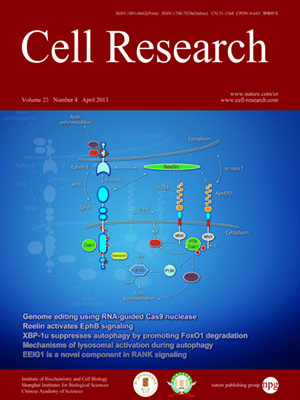
Volume 23, No 4, Apr 2013
ISSN: 1001-0602
EISSN: 1748-7838 2018
impact factor 17.848*
(Clarivate Analytics, 2019)
Volume 23 Issue 4, April 2013: 473-490
ORIGINAL ARTICLES
Reelin induces EphB activation
Elisabeth Bouché1,2,*, Mario I Romero-Ortega3,*, Mark Henkemeyer4, Timothy Catchpole4,Jost Leemhuis1,8, Michael Frotscher1,5, Petra May1,2,6, Joachim Herz1,7 and Hans H Bock1,2,6
1Center for Neuroscience, Albert-Ludwigs-University, Albertstrasse 23, D-79104 Freiburg, Germany
2Department of Medicine II, Albert-Ludwigs-University, Freiburg, Germany
3Department of Biomedical Engineering, University of Texas at Arlington, Arlington, TX 76019, USA
4Department of Developmental Biology, University of Texas Southwestern Medical Center, Dallas, TX 75390, USA
5Center for Molecular Neurobiology, Hamburg, Germany
6Clinic for Gastroenterology, Hepatology and Infectiology, Heinrich-Heine-University Düsseldorf, Moorenstrasse 5, D-40225 Düsseldorf, Germany
7Department of Molecular Genetics, University of Texas Southwestern Medical Center, Dallas, TX 75390, USA
8Present address: Roche Pharma AG, D-79639 Grenzach-Wyhlen, Germany
Correspondence: Hans H Bock,(hans.bock@zfn.uni-freiburg.de; HansHenrich.Bock@med.uniduesseldorf.de)
The integration of newborn neurons into functional neuronal networks requires migration of cells to their final position in the developing brain, the growth and arborization of neuronal processes and the formation of synaptic contacts with other neurons. A central player among the signals that coordinate this complex sequence of differentiation events is the secreted glycoprotein Reelin, which also modulates synaptic plasticity, learning and memory formation in the adult brain. Binding of Reelin to ApoER2 and VLDL receptor, two members of the LDL receptor family, initiates a signaling cascade involving tyrosine phosphorylation of the intracellular cytoplasmic adaptor protein Disabled-1, which targets the neuronal cytoskeleton and ultimately controls the positioning of neurons throughout the developing brain. However, it is possible that Reelin signals interact with other receptor-mediated signaling cascades to regulate different aspects of brain development and plasticity. EphB tyrosine kinases regulate cell adhesion and repulsion-dependent processes via bidirectional signaling through ephrin B transmembrane proteins. Here, we demonstrate that Reelin binds to the extracellular domains of EphB transmembrane proteins, inducing receptor clustering and activation of EphB forward signaling in neurons, independently of the 'classical' Reelin receptors, ApoER2 and VLDLR. Accordingly, mice lacking EphB1 and EphB2 display a positioning defect of CA3 hippocampal pyramidal neurons, similar to that in Reelin-deficient mice, and this cell migration defect depends on the kinase activity of EphB proteins. Together, our data provide biochemical and functional evidence for signal integration between Reelin and EphB forward signaling.
Cell Research (2013) 23:473–490. doi:10.1038/cr.2013.7; published online 15 January 2013
FULL TEXT | PDF
Browse 2331


